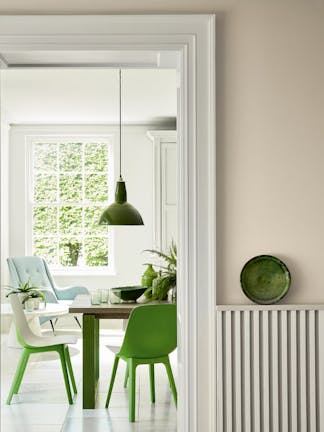To get the best out of your home decorating, we recommend a few preparatory steps. We have prepared a few painting tips to help you achieve flawless interior design. Read our expert advice to find out everything you need to know before painting a room.
Preparing the Room for Painting
Before you begin decorating, it’s important to start by preparing your space and gathering the right equipment.

Protect your surrounding surfaces:
- Remove or roll up rugs and curtains. Move furniture to the centre of the room and cover it to protect it.
- Put down a dust sheet, card or paper to protect the floor.
- Remove any picture frames or fixtures from walls. Loosen (or completely remove) any switch and socket plates, door and window handles. Loose fittings will be easier to tape before painting.
- Mask the edges of any glazing in windows and doors, and all pre-painted woodwork using low-tack painter’s tape.
Prepare your painting surface:
- Make sure to remove any loose paint / plaster / wallpaper completely, and ensure the surface is dry.
- If painting over wallpaper, make sure all seams are properly glued.
- Rake out and fill any holes and cracks, seams and imperfections with proprietary filler.
- Sand the dried filler smooth with fine abrasive paper.
- For the best finish, sand all areas very lightly before painting.
- Remove all dust and debris from walls using a damp cloth, tack cloth or vacuum cleaner.
Read expert advice for preparing a room from our Creative Director, Ruth.
Painting a Wall: Our Top Tips
Follow these expert painting and decorating tips when you begin your project. For more comprehensive step-by-step advice, read our guide on how to paint a wall.

Protect your floors:
With your walls prepared, lay a flattened corrugated box on the floor. Its padded surface will protect the floor and soak up any drips better than polythene sheets.
Mix your paint:
Set out your tools, then open the paint and give it a good stir. Make sure to mix the paint all the way to the bottom of the tin.
Work around your radiators:
Radiators are difficult to remove from walls during decoration. Protect them with a dust sheet or similar and paint behind them, as far down the wall as you can. Bear in mind that you may be able to see the wall through column radiators. A long-handled mini roller can help with this.
If you plan to paint your radiator as well, read our expert guide.
Paint edges first:
Begin by ‘cutting-in’: carefully painting the edges of the walls. Use a one or two inch straight-edge brush for this initial stage. You won’t be able to ‘cut in’ accurately with a roller or bigger brush.
Working from the ceiling down, paint a two or three inch frame around all the edges of the wall. Paint the wall corners, edges of the skirting board and around windows, doors, light fixtures, sockets and switch plates.

Don’t overload your paint brush:
Decant just an inch or so of paint into an easy-to-handle container. Only dip the bristles of your brush half-way into the paint. Try to avoid getting paint into the ferrule (the metal sleeve that holds the bristles). Clear excess paint from the sides of the brush by dragging them lightly over the lip of the container.
Saturate your roller:
Pour about an inch of paint into the deep reservoir end of the paint tray. Leave the other end of the tray clear. Dip the roller into the tray and allow the paint to soak into the sleeve. Then move your roller back and forth on the roller bed.
The roller should be evenly saturated with paint, but not overloaded. As a test, the roller should spin easily and smoothly in the air, without dripping any paint.
Paint evenly in sections:
Work from the ceiling down, roll paint in areas of about one metre (three feet) square at a time. Work the roller up, down and across until you’ve covered the area evenly. You’re aiming to apply an even thickness of paint across the whole surface. Cover the entire wall in this way, square by square.
Cover uneven areas whilst wet:
If paint begins to build up at the edges of the roller stroke, gently roll out the lines immediately. Water-based paints start drying quickly, so don’t go back over tacky paint as you will ruin the surface.
Allow drying time between coats of paint:
Keep the roller loaded and watch out for patches where paint is too thin. If another coat is necessary, allow the paint to dry properly before repeating.
For more tips and guidance, download our PDF Advice Sheet of expert painting and decorating tips.
For further tips about using our paints, read our Paint FAQs.
Or browse our paint colours and finishes to choose the ideal shades for your project.
Please note: the information and advice presented in this article is given in good faith. We cannot guarantee particular results, as situations and usage are outside our control.

